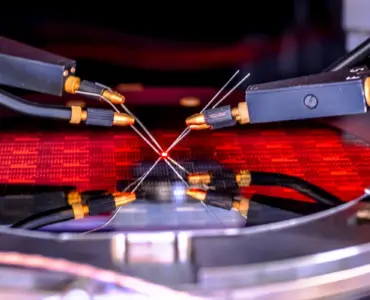Faster, higher, further – our high-frequency scientists are working to develop and characterize key electronic components of the future. While we, as a society, are still at the fag end of the 4G-era, research for 6G is already well underway. It’s only a question of time, until it is the new standard.
Today, RealIZM speaks with Oliver Schwanitz, Group Leader of High-Frequency Interconnects & Components at Fraunhofer IZM, to find out more about what it means to be a researcher in the field of high-frequency system development.
To start off: You are working with RF interconnections and components. What does that entail?
Oliver Schwanitz: That’s a huge field in general. But since we are an electronics packaging institute, our focus is guided by the developments and demands for components in the packaging and system-integration sector.
The world of communication is constantly changing. Currently, we are seeing a shift to 5G, and eventually this will lead to 6G. With 5G millimeter-wave (mmWave), we are working with frequency ranges such as 24 – 29 GHz and 37 – 40 GHz. With these frequencies, you need to use very specific components and interconnects for your signal to be conducted properly within the system. It’s not as simple as pressing a button to turn the power. You need solutions that can withstand high frequencies without any major changes to their parameters, so you can route your signal through the whole package. And because it’s such an open-ended topic, there are a lot of different approaches.
What are some of the more practical challenges when working with such high frequencies?
Oliver Schwanitz: Accurate and reliable measurement-based results. It is one thing to model and simulate something using a computer, but it’s something else altogether to measure it in the real world. But measurements are extremely important for validating concepts, theories and assumptions.
We have several different techniques for measurement-based validation. From measuring interconnects using a vector network analyzer up to 500 GHz, to measuring the radiation characteristics of antennas using an anechoic chamber up to 325 GHz. It really depends on the specific components and field of application.
How does this work? Do customers come to you with a blueprint in hand and you just need to do a feasibility analysis?
Oliver Schwanitz: Not quite. When someone approaches our department with a project, it’s mostly from a top-down perspective. They want to build something but need us to work out the details. So we think about the hardware system architecture, system-integration approach, packaging technology, the arrangement of the different layers within the package, which materials to be used and how to interconnect all the different components together. One typical question is: What kind of interconnect gets us from one layer to the next? You could use through-hole, buried or blind vias. Within the layers you could use interconnects such as microstrip lines, stripline or coplanar transmission lines. All of that depends on the configuration of the conductors in the package. In the end, you want your signals to propagate as near to loss-free as possible.
The institute is a global player in that regard. We have the research group of Dr. Tanja Braun and Karl-Friedrich Becker who work on fan-out wafer-level packaging, and we have Dr. Andreas Ostmann, who works on PCB embedding. These are two very sophisticated packaging techniques to build high-frequency modules that are at the forefront of current research.
What are some of the projects you are currently working on? Do you have any projects in the 6G field?
Oliver Schwanitz: Yes, we are currently working on many 6G projects. For example, 6GKom. It’s a BMBF project where we develop 6G hardware modules for frequencies up to 170 GHz. For this, we are using our patented fan-out wafer level-based antenna-in-package module. So, we have a fully embedded system and use that to see what happens when we are working with signals in the 170 GHz range.
The first step is to cooperate with other groups to develop the entire stack-up concept. Based on that concept and the given packaging technology, we can then start on designing interconnects. Since this is a module for 6G mobile communication applications, we are also designing the antennas in parallel. These are then combined with interconnects to form a complete signal path.
All individual components and interconnects are manufactured individually as a test structure and then measured to verify the simulations. If everything fits, then the entire module will get built at the end, of course.
What have been some of the insights from your 6G research?
Oliver Schwanitz: We noticed that we are nearing the limits of what is physically measurable. Your measurement tools need to be accurate enough to measure your structures precisely.
So another important question is: How do we build our structures so that we are still able to get accurate readings from our measurements? With 6G, the frequencies become so high that the structures for them have to be so very small. But we need measurements as the ultimate validation.
Moving forwards, what trends do you see for the future of high-frequency technologies?
Oliver Schwanitz: Embedded components. This means that you integrate your structures in all three dimensions and across the whole package. With higher frequencies you need shorter distances, so we embed everything. Otherwise, you would create a signal path that behaves like an antenna and goes out in all directions.
Another trend is glass. We are already used to glass fibers, but new developments are moving towards glass as a material for whole circuit boards or even antennas. Glass has promising material properties and allows high data rates.
Speaking of frequency distribution – what’s happening with 6G in this regard?
Oliver Schwanitz: Not much. But the need is there. Because the frequency spectrum is limited, you can only put so much traffic into each frequency range. And with 4G, we are already using most of it. Mobile phones, DVBT, radio … there isn’t much room left. 6G opens up new frequencies. And because you don’t want to simply turn off the old 3G or E networks, the only way is up.
Which areas will benefit the most from these technologies?
Oliver Schwanitz: The automotive sector and machine-to-machine communication sector are two examples. But it’s not limited to cars. Drones, for example, benefit a lot from higher data transmission rates as well. And there have been plenty of ideas about using them more for public services (like monitoring woods to prevent fires). There is quite a lot of untapped potential and it will be interesting to see where these new technologies take us.
Where would you see the greatest obstacles for implementing 5G in the real world?
Oliver Schwanitz: Today, 5G sub 6GHz is being rolled-out worldwide. The next step will be 5G mmWave. There are still a lot technological challenges that must be overcome to develop miniaturized and cost-effective 5G mmWave hardware solutions. In addition to these technological challenges, I think there are also administrative challenges. For one, you need to regulate the frequency bands. It took a long time to get 4G up and running and there are still plenty of remote areas where you are happy to even get an edge connection.





Add comment